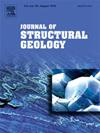The role of cretaceous tectonics in the present-day architecture of the nice arc (Western Subalpine foreland, France)
IF 2.9
2区 地球科学
Q2 GEOSCIENCES, MULTIDISCIPLINARY
引用次数: 0
Abstract
The Nice arc architecture, located at the southern tip of the Western Alps, is very singular, with a strong and narrow curvature. This particular shape could be the result of inherited structures that guide subsequent deformations during compressional events, as has been demonstrated in other parts of the belt. To achieve this objective, we adopted a multidisciplinary approach to characterize the geometry, kinematics, and timing of deformations associated with the various tectonic episodes that structured the arc. A special focus on the Cretaceous formations has revealed that the Cenomanian deposits show significant thickness variations and strong disturbances associated with fault activity. At this time, the formation of narrow, elongated basins was controlled by a system of NNE-SSW trending left-lateral strike-slip faults associated with NW-SE trending normal strike-slip faults and normal faults, dated at 81 ± 13 Ma on calcite recrystallised on the fault planes. During the Cenozoic, two phases of shortening reactivated the faults bounding these basins. An Oligocene phase corresponds to a NE-SW compression, expressed by NW-SE trending folds and thrust and reactivation of first phase faults, dated at 28.7 ± 6.1 Ma, 28.8 ± 8.4 Ma and 27.3 ± 6.3 Ma. The Mio-Pliocene phase is characterised by N-S compression with E-W folds that interfere with the Oligocene folds and reactivate the earlier faults. A Lower Miocene age of 18.2 ± 1.1 Ma and a Pliocene age of 3.16 ± 0.47 Ma pinpoint the timing of these last deformation phases.
白垩纪构造在尼斯弧现今构造中的作用(法国西亚高山前陆)
尼斯弧形建筑位于西阿尔卑斯山的南端,非常独特,具有强烈而狭窄的曲率。这种特殊的形状可能是在挤压事件中引导后续变形的继承结构的结果,正如在带的其他部分所证明的那样。为了实现这一目标,我们采用了多学科方法来描述与构造弧的各种构造事件相关的几何、运动学和变形时间。对白垩纪地层的特别关注表明,Cenomanian矿床显示出明显的厚度变化和与断层活动相关的强烈扰动。这一时期,狭长型盆地的形成受NNE-SSW走向的左旋走滑断裂与NW-SE走向的正走滑断裂和正断层相结合的体系控制,该体系的形成时间为81±13 Ma,断裂面上方解石重结晶。在新生代,两个阶段的缩短使这些盆地的断裂重新活跃起来。渐新世为NE-SW挤压期,表现为NW-SE向褶皱、逆冲和第一期断裂的再活化,时间分别为28.7±6.1 Ma、28.8±8.4 Ma和27.3±6.3 Ma。中新世—上新世阶段的特征是南北向挤压,东西向褶皱干扰渐新世褶皱,使早期断裂恢复活动。中新世下年龄(18.2±1.1 Ma)和上新世年龄(3.16±0.47 Ma)确定了这些最后变形阶段的时间。
本文章由计算机程序翻译,如有差异,请以英文原文为准。
求助全文
约1分钟内获得全文
求助全文
来源期刊

Journal of Structural Geology
地学-地球科学综合
CiteScore
6.00
自引率
19.40%
发文量
192
审稿时长
15.7 weeks
期刊介绍:
The Journal of Structural Geology publishes process-oriented investigations about structural geology using appropriate combinations of analog and digital field data, seismic reflection data, satellite-derived data, geometric analysis, kinematic analysis, laboratory experiments, computer visualizations, and analogue or numerical modelling on all scales. Contributions are encouraged to draw perspectives from rheology, rock mechanics, geophysics,metamorphism, sedimentology, petroleum geology, economic geology, geodynamics, planetary geology, tectonics and neotectonics to provide a more powerful understanding of deformation processes and systems. Given the visual nature of the discipline, supplementary materials that portray the data and analysis in 3-D or quasi 3-D manners, including the use of videos, and/or graphical abstracts can significantly strengthen the impact of contributions.
 求助内容:
求助内容: 应助结果提醒方式:
应助结果提醒方式:


